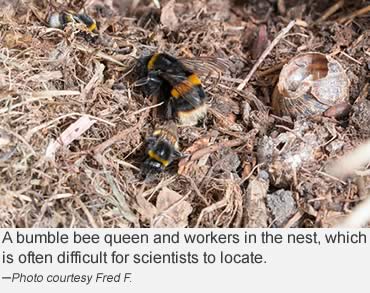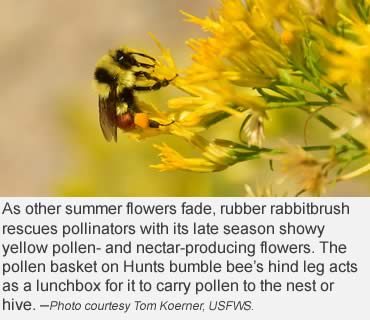Fall has arrived and it’s time for bumble bees, bears, groundhogs and bats to hibernate.
Huh? Bumble bees hibernate?
Yes, they do! America’s native bee, the humble bumble bee—that large, buzzy, furry pollinator, mostly black with yellow, white or orange stripes—takes a long winter nap every winter.
Although bumble bees may share some family ties with honey bees, hibernation isn’t one of them.
There are 46 species of North American native bumble bees, some that live as far as the Arctic Circle, and others live border to border in the continental United States. Bumble bees are native pollinators and they’ve been pollinating the continent’s flowering plants long before the arrival of honey bees.
There were no honey bees in America before European settlers brought their hives with them, and settled in, but then those European honey bees escaped domestication and spread across the country.
 Both bumble bees and honey bees form colonies with one queen and many workers, but a bumble bee colony is never as big, nor do bumble bees live as long as the bees in a honey bee colony.
Both bumble bees and honey bees form colonies with one queen and many workers, but a bumble bee colony is never as big, nor do bumble bees live as long as the bees in a honey bee colony.
When temperatures cool and drop to the 50s, honey bees cluster around their queen. As temperatures continue to drop, they cluster more tightly, and consume honey they stored as fuel to produce body heat to keep their hive warm.
Bumble bees don’t have a colony to maintain over winter months.
In fall, as bumble bees consume the nectars from fading summer flowers, the queen’s last summer brood is born, producing a number of new queens. Each queen mates and then finds a resting spot, often a small burrow just large enough for one, in which she’ll spend the winter months.
In hibernation, the queen does not eat or work, and her metabolism is extremely depressed, allowing her to live for the long cold period without food. Unlike the restful winter, spring is filled with activity for the queen bumble bee.
After awakening, she’ll find a more spacious ground nesting spot, usually a small burrow or an abandoned mouse or rodent nest. Then she’ll build a few wax pots and fill them with pollen and honey, and lay her eggs, usually a half dozen, before she rests on top of them, keeping them warm.
 All the new bumble bees born will be sterile female worker bees, and once they are grown, the queen will not leave the nest. Instead, she’ll spend all her time laying more eggs.
All the new bumble bees born will be sterile female worker bees, and once they are grown, the queen will not leave the nest. Instead, she’ll spend all her time laying more eggs.
The new bumble bee colony will grow rapidly to a few hundred workers.
Near the end of the summer, the queen will lay male as well as female eggs, which mate after emerging from the nest. All the worker bees and the old queen will die at the end of the summer, and the new queens have already mated.
The temperatures cool, the new queens find a secure spot to nap for a few months before spring warms and wakes them for the new cycle of life.
Biologists and naturalists who monitor bumble bees are often frustrated because the nests are known for being very difficult to locate. Unlike the intense activity of a honey bee hive, bumble bee worker bees, like most other worker bees, do not readily reveal the hive location.
The value of all bees, as well as bats, moths and birds, is for the extremely valuable pollination services they naturally provide to agricultural and horticultural crops.
Did you know bumble bees are important for your salad tomatoes?
One type of bumble bee, the pale “impatient” bumble bee, native to the Eastern United States, is the most commonly used pollinator for greenhouse tomatoes. There are several crops honey bees do not pollinate such as tomato or eggplant flowers, and they are known as poor pollinators for many native plants such as pumpkins, cherries, blueberries and cranberries. Fortunately, bumble bees excel at pollinating those plants.
Both queen and worker bumble bees can sting, but unlike honey bee, a bumble bee stinger which has no barbs means it can sting repeatedly without injuring itself. It also means the stinger won’t be left in the wound. The good news is bumble bees are not known to be aggressive, and they rarely sting.
–Resources: United States Department of Agriculture, NatureServe and the USDA Forest Service.